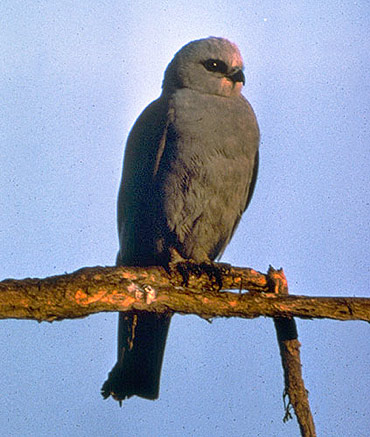|
| Query: horned lizard | Result: 70th of 82 | |
Mississippi Kite (Ictinia mississippiensis) - Wiki
| Subject: | Mississippi Kite (Ictinia mississippiensis) - Wiki
| |

| Resolution: 370x437
File Size: 54524 Bytes
Upload Date: 2007:10:22 11:29:26
|
Mississippi Kite
From Wikipedia, the free encyclopedia
[Photo] Mississippi Kite (Ictinia mississippiensis), USFWS photo. Source: Migratory Birds Photo Gallery - National Zoo http://nationalzoo.si.edu/Animals/PhotoGallery/MigratoryBirds/default.cfm
The Mississippi Kite Ictinia mississippiensis is a small/medium-sized, sleek raptor in the family Accipitridae. It is primarily light to dark gray and black. It is long-winged, acrobatic and graceful in flight, can soar for long periods, and may stoop vertically at high speed for prey. Kites breed in the S.E. United States north in various densities to N. Virginia, W. Tennessee, S. Indiana, S. Illinois, S.E. and E.C. Missouri]; is dense in much of the south half of central and western Kansas, much of central and western Oklahoma and Texas; occur in a few scattered locations in Nebraska and NE Colorado, and are common in much of SE Colordo. They are also common in E.-C New Mexico, and are found in a few other scattered locations in New Mexico and Arizona. They are known to nest out of the U.S.A only rarely in N. Mexico, and migrate, sometimes in huge flocks, to parts of South America. Kites usually lay 2 eggs, occasionally only one, and very, very rarely 3 in a stick nest in a great variety of deciduous trees from 6 to 100+ feet, usually 20 - 60 depending on tree size and species. In the past 75 years they have undergone changes in nesting habitat from use of broken and continuous forest, gallery forest, and savanna, to include shelterbelts and other small man-created tree groups of various sizes. They are now very common nesters in urban areas of all sizes in the western states and some south-central states.
Mississippi Kites flock, nest singly or in colonies of various densities and sizes, are very gregarious, and non-territorial. Their diet consists of large quantities of insects and considerable numbers (at least in many areas) of small mammals, birds, snakes, lizards, and frogs. They will scavenge road kills. Kites, especially nestlings and adults on nests, are often killed and eaten at night by other large vertebrate carnivores such as raccoons and great-horned owls. They are very aggressive to these threats during the day. Probably because they are aggressive to perceived threats to their nests, they sometimes pose a problem for management and education in Kansas, Oklahoma, Texas, and New Mexico where large numbers of kites nest in urban habitat such as parks, residential areas, and golf courses. The problem is based on their occasional, but sometimes persistent willingness to treat people as predatory threats to their nests and young by diving rapidly at those who venture too close to the nest trees; almost always those where nests are low to the ground. The danger to humans who understand their behavior is almost nonexistent, although there are cases of actual injury to people.
http://en.wikipedia.org/wiki/Mississippi_Kite
| The text in this page is based on the copyrighted Wikipedia article shown in above URL. It is used under the GNU Free Documentation License. You may redistribute it, verbatim or modified, providing that you comply with the terms of the GFDL. |
|
Comments |
|---|
| | Guest |
|
Scientific Name: Ictinia mississippiensis (Wilson, 1811)
Common Names: Mississippi Kite
French: Milan du Mississippi; German: Mississippiweih; Spanish: Elanio del Misisipi
Taxonomy: Falco misisippiensis [sic] A. Wilson, 1811, below Natchez, Mississippi, USA.
Synonym(s): Ictinia misisippiensis (Wilson, 1811); Falco misisippiensis Wilson, 1811 |
^o^
Animal Pictures Archive for smart phones
^o^
|
|
|